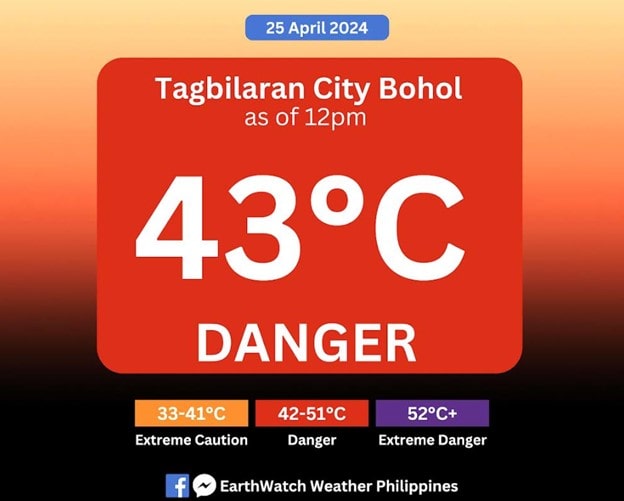
TAGBILARAN hits 43 degrees Celsius heat index being observed as of 12 noon on April 25, but it cools down to 39 degrees C the following day, according to Earthwatch Weather Philippines. (EWP).
Inabanga town heat index breached 40 degrees C of the same day (April 25), according to Mayor jono Jumamoy in his post in facebook.
PAGASA predicted earlier that Panglao International Airport would hit 41 in April 22; 40 in April 23; 39 in April 24 and 25; and 40 in April 26.
The actual data for the city were gathered from local Automated Weather Station (AWS) installed at the Office Operations Center of the City Disaster Risk Reduction Management Office (CDRRMO).
The same temperature experienced in the city a day prior.
The situation is under the “danger” effect-based classification between 42-51 degrees C, it said.
Under the “Danger” condition, “heat cramps and heat exhaustion are likely; heat stroke is probable with continued activity,” the agency warns.
Among the symptoms of heat-related illnesses to watch out for are sweating heavily, exhaustion or fatigue, dizziness, blacking out, weak but fast pulse, feeling of nausea, and vomiting.
Among the prevention measures Pagasa suggested are limiting the time spent outdoors, drinking plenty of water, bringing umbrellas, wearing hats and sleeved clothing, and scheduling heavy-duty activities for the beginning or end of the day when it’s cooler.
Philippine Atmospheric, Geophysical, Astronomical Services Administration (PAGASA) earlier warned of hotter days in May.
Two earlier, the city hit the 41 degrees C while Siquijor and Cebu city at 39°C at 2 in the afternoon, which temperature dubbed as extreme caution.
As this developed, EWP “advises the public to stay hydrated by drinking eight glasses of water and, as much as possible, avoid outdoor activities and wear light-colored, loose clothing.
If going out cannot be avoided, make it a habit to rest every 30 minutes to give the body time to rest and cool down, and to avoid heat exhaustion and heat stroke.
Report said that volcano eruption has something to do to blistering heat.
Yahoo reported that “When Mt. Ruang in Indonesia underwent multiple explosive eruptions last week, volcanic gases were flung so high they reached the atmosphere’s second layer, tens of thousands of feet above ground.”
The volcano’s eruption this week ejected an ash plume and volcanic gases in about 65,000 feet into the air based on satellite estimates.
It impacts, though maybe in short-term, to weather and climate “even as the danger posed by the volcano persists and evacuations continue.”
“But Mount Ruang’s influence on the climate will likely be minimal, according to Greg Huey, the chair of Georgia Tech’s School of Earth and Atmospheric Sciences.” (rvo)



